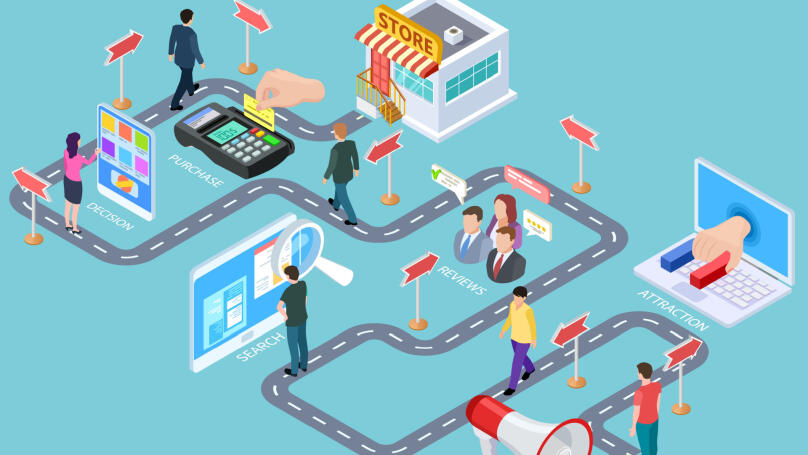Customer Journey Map

What is a customer journey map?
By definition, a Customer Journey Map is a unique marketing tool for visualising the experience of customer interaction with the company. All the map's components, such as the needs and desires of customers, their emotions and associations that they get after interacting with the brand, are displayed graphically. Thus, the Customer Journey Map, or CJM, is a table, chart, infographic, or any other visually designed document.
Such a map reproduces in detail the path the consumer follows from realising the need to acquire a particular product to its purchase. This allows you to look at the brand through the eyes of buyers and understand their goals, motives, financial habits and fears. Moreover, a detailed analysis of the target audience helps you determine what actions you need to take at each stage of interaction so that the customer remains satisfied and returns later.
Benefits of customer journey mapping
CJM contributes to a brand's most effective and profitable interaction with its potential audience. Thus, mapping allows you to solve the following tasks:
-
finding out what stages the customer passes on the way to buying a product and what goals they pursue;
-
realising how different audience segments interact with the company;
-
discovering the pressing problems that the customer faces at different stages of their journey, and finding ways to solve them;
-
identifying all the points at which the audience interacts with the company (this is not only about the direct purchase of goods but also visiting the official website, clicking on ads on various resources, chatting with consultants, calling the hotline, attending a master class or workshop from the brand's leading experts);
-
noticing the barriers between the company and the audience, overcoming them and preventing this from happening in the future;
-
evaluating the quality of service and improving customer interaction;
-
optimising the retail system and eliminating all previously made mistakes;
-
developing a strategy or detailed communication plan for each stage of the customer journey.
Therefore, the benefits of customer journey mapping are evident:
-
boosting consumer loyalty and focusing on customers;
-
expanding the customer base and increasing brand awareness;
-
shortening the sales cycle;
-
reducing the risk that the customer will stray from the intended path without buying your product, and, as a result, stabilising sales.
Customer Journey Map Types

There are several varieties of CJM, each with its own advantages. Depending on the purpose of its compilation, you should decide which of them is most appropriate to use in various situations:
-
Current State Map
This is the most commonly used map type. It shows what thoughts, feelings and emotions the company's customers are experiencing at the moment. In other words, such a CJM does not involve the analysis of existing experience or, conversely, the visualisation of the future. Its task is to reproduce the path of the customer, which they are currently on. It is these CJMs that you should create regularly to constantly improve consumer interaction with the brand.
-
Customer Day Map
Such maps visualise thoughts, feelings and emotions that customers experience in their daily lives regardless of whether these experiences directly relate to your company. This kind of CJM allows you to find out much more information about the preferences, desires and pressing issues of potential customers. By and large, this gives you a broad picture of the life of the audience and allows you to anticipate its needs. Therefore, such maps are best used to create a development strategy for a new product that will satisfy customer needs that have not yet arisen.
-
Map of the Future
Such CJMs are based on past customer experience journey mapping and are used to predict what actions, thoughts and emotions customers will experience during future interactions with the company. Therefore, maps of the future are best used to illustrate certain business developments and set clear strategic goals.
Creating a Customer Journey Map

The main rule for achieving success and popularity of the company is as follows: do not rely on guesswork and assumptions! In the process of creating a Customer Journey Map, you should focus on research and analytical and statistical data. Drawing up a customer map involves interviewing potential audiences and conducting regular surveys. Furthermore, it is better to entrust the design of CJM to a separate team of experts, which should include marketers, analysts, UX designers and specialists in various other areas. The main objective is to increase the demand for the company and its product, making it convenient and user-friendly.
So, the main customer journey map stages are as follows:
Stage 1. Preparing and collecting data
For the customer journey map to bring certain results, it is essential to clearly identify guidelines and adhere to them at all further stages. First of all, define the main purpose of compiling the CJM, for example:
-
to determine the level of satisfaction with the company's products;
-
to identify brand weaknesses when interacting with the customer;
-
to boost sales;
-
to increase customer loyalty and brand awareness among potential audiences.
The goals and objectives of compiling a CJM may differ depending on how the company itself operates and what audiences it focuses on. Models of business interaction with the audience include:
- B2C - implies a relationship between the company and individuals, that is, ordinary consumers;
- B2B, or "business to business". In this case, the company provides its goods or services not to a mass audience, but to other companies;
- B2G, when the company provides certain services to the government.
One way or another, the customer journey map applies to any business, be it fashion retail, consulting services, the automotive industry, banking, jewellery or any other area. In any case, to compile the CJM and conduct the most complete analysis, you need to collect a lot of information and input data. Sources can be various analytics systems, information from surveys and questionnaires, conducting full-fledged focus groups, comments and reviews on social networks. We should mention that at each of the following stages of compiling the CJM, you need to conduct interviews, questionnaires or any other surveys of the company's potential customers to obtain the most accurate and detailed results.
Stage 2. Determining the buyer persona
A customer journey map is compiled for a specific type of consumer, united by similar characteristics, such as age, interests, geographic location, gender, social status and income level. Therefore, if the audience of your brand is wide and diverse, you need to segment it by key feature and then create several CJMs for each group of customers.
So, the buyer persona is a collective image based on previously obtained analytical data and reflecting the characteristics of this particular type of customer or a certain audience segment. That is, at the second stage, in addition to learning how the customer found out about your company and why they decided to use the product, you need to find out:
-
your customer's personality;
-
their motives and goals;
-
financial habits and fears;
-
expectations from purchasing a particular product;
-
feelings and emotions arising in the course of interaction with the brand;
-
difficulties, problems and barriers;
-
all arising issues and doubts.
In addition, you should separately study the behaviour of your customer at each of the stages that they go through on the path to buying. These stages represent the following steps of consumers on the way to meeting their needs:
-
Recognising the need, which is influenced by many factors: from upbringing and psychological traits to weather conditions at the moment.
-
Searching for information; during this process, the customer becomes interested in the possibility of acquiring the product they require.
-
Analysing the received information about the product, searching for alternatives, and comparing the options found.
-
Making a decision and acquiring the product.
-
Consuming the product and consequently deciding whether to buy it again or not.
If you study the interests, values, desires and motives of each group of customers, attracting and retaining your audience will become much easier and more effective.
Stage 3. Finding common ground between the company and customers
At this stage, it is essential to find out at what specific moments the customer comes into contact with your brand, that is, when and under what conditions direct interaction occurs. This can be either visiting a website or application or communicating with a manager or consultant, meeting a courier, calling a hotline, rating the product itself and writing a review. It does not matter how this interaction is carried out, online or offline. The point is that this affects the further perception of the brand, the level of consumer satisfaction and their desire to remain your customer.
When compiling a CJM, you should determine all the likely points and levels of interaction between the company and the audience. Do not forget to take into account indirect communication channels: various types of advertising, posts on social media, and search engines. You should also identify those actions or factors that particularly influence the customer and most often lead them to make a purchase. Talk with potential customers through surveys or questionnaires discussing information channels through which consumers learned about the company, whether it was convenient for them to place an order, what they would like to change, and so on.
Stage 4. Identifying and removing barriers
You need to determine the feelings and emotions that the buyer experiences at each stage of their journey. For example, making an order online can be complicated due to the site's inconvenient interface. In this case, users will feel annoyed.
Thus, the key task of this stage is the detection of barriers. In other words, you determine the factors that prevent the consumer from making a purchase or make them doubt the decision. These could be technical issues on the site, incomprehensible design and layout of elements in the company's app, negative reviews from other consumers, or unfriendly employees in the store. All this is called "customer pain" - something that causes discomfort, issues, and even fears in consumers. In this case, the company's task is to find the most effective solution to these problems. Otherwise, it risks losing a significant part of its audience. You need to conduct a survey of the audience and find out what exactly does not suit right with customers and how best to fix it.
Stage 5. Analysing and mapping the information received
In the process of moving from one stage to another, the resulting analytical data should appear in the CJM table or chart. In the end, the map must show:
-
the main goals of compiling the CJM and ways to achieve them;
-
portrait of the target audience and each of its segments;
-
a detailed description of the stages that customers pass before buying the product;
-
emotions, fears and challenges customers face along the way;
-
solutions for every emerging barrier.
Thus, the Customer Journey Map will make the customer experience as comfortable, convenient and understandable as possible.
Tips for creating a Customer Journey Map

A CJM is a complex marketing tool that is considered one of the most energy-intensive ways to increase customer loyalty and requires certain skills. So that you do not waste time, here are some tips for creating a CJM:
Tip 1. Customers first
Although the first step in creating a CJM is to set a key goal, you should not focus solely on the goals of the company. Remember that the customer journey map is compiled primarily for the customer and your target audience. Therefore, companies need to adapt to consumers and not try to re-educate them to suit their needs.
Tip 2. Distribute task wisely
For a CJM to bring tangible results, it is necessary to appoint several specialists who will be responsible for certain changes and improvements implemented per the received data. The team may consist of marketers, analysts, designers, etc. In other words, to compile the CJM competently, you require specialists from different fields. It is also essential that all employees are interested in improving the brand's interaction with customers.
Tip 3. Pay attention to all details
You should take equally seriously all the touchpoints of customers and the company. Even if you receive much more orders online than by phone, you should carefully study both dealing with calls and online sales.
Tip 4. Update your CJM regularly
When a new product is released, or even slightly changed, the customer journey also changes. Some innovations can become a hindrance for consumers, while others, on the contrary, will speed up the decision to purchase a particular product. Therefore, it is crucial to monitor how various external and internal circumstances affect the CJM. Depending on the data received, the map must be constantly improved.
Tip 5. Experience the customer's journey
The CJM team needs to test the convenience of buying a product themselves, for example, to find out how easy it is to place an order in an online store or through an app. In other words, the company employees must also have an idea of what they are working with.
Tools for creating a Customer Journey Map
CJM creation tools are the best way to digitally map the customer journey not only through tables and charts but also through more complex diagrams and infographics.
- UXPressia
It is a cloud-based customer experience management platform that helps teams visualise and further improve the stages of customer interaction with the company on the way to purchase products. It involves working on custom templates and creating your own unique CJM models.
- Lucidchart
This is a tool that also reflects the impressions of customers from interacting with the company. With customisable templates and rich formatting options, the software makes it easy to visualise and share customer journey results, helping a company navigate how their customers actually feel along the journey to a purchase. It also increases customer engagement and loyalty, which ultimately leads to increased sales.
- Microsoft Visio
This software is designed specifically for drawing up various diagrams and more complex charts. It also includes many built-in forms, stencils, and templates for visualising all kinds of processes. It simplifies the reproduction of graphs and other structures for the user as much as possible.
- Gliffy
This is a simpler tool for the visualisation and subsequent editing of the created charts. Compared to all previous services, Gliffy is the easiest to learn. Moreover, it is one of the most lightweight programs. However, it provides a significantly smaller number of charting templates.
- Custellence
It is also one of the simplest and most intuitive programmes used to create all sorts of graphs, charts and diagrams. It offers fast onboarding, a flexible structure, a lot of templates and ready-made models, a unique collection of images and an attractive design.
- Google Sheets
This is a free tool that does not require any subscriptions or additional skills in working with image editors. Programmes such as Google Sheets are best suited for compiling small CJMs, or for organising data for each step of the mapping process.
- Cork or magnetic whiteboards
This is the simplest and most budgetary, but limited way to create a CJM. Only small companies can place an entire customer journey map on one board. Of course, at the first stage of planning, you can sketch out a rough outline of the future Customer Journey Map on a regular office board. However, in the future, you will need to use a graphical editor for the most complete and accurate visualisation. In addition to the above programmes, you can use the following services:
- Touchpoint Dashboard;
- RealtimeBoard;
- Сanvanizer.
And if professional designers also take part in developing the map, you can safely use Figma, Adobe Photoshop, and Illustrator.
So, the Customer Journey Map has been a real must-have for any business over the past few years. This is a universal marketing tool and an effective way to study your customers in detail, form strong emotional bonds with them and, consequently, increase loyalty.























